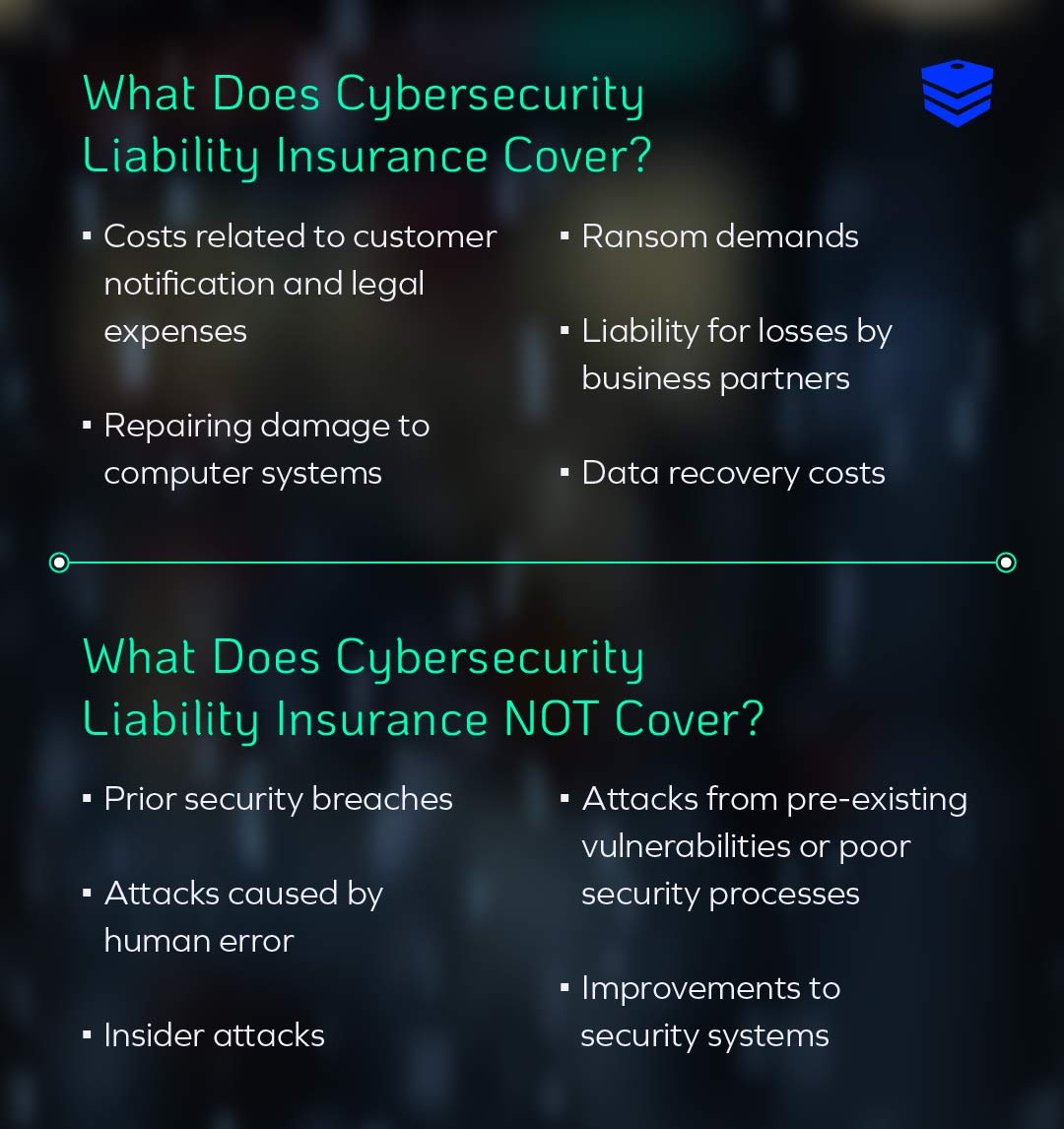Cybersecurity Consulting
Cybersecurity Insurance Requirements Needed to Get Coverage in 2024
January 02, 2024
7 Minutes

Cyberattacks can be devastating to businesses of any size. To soften the blow and mitigate the financial risks, organizations often get cybersecurity insurance. But many companies don’t understand that there are cybersecurity insurance requirements that providers look for before even considering building you a policy.
You can’t just get a quote online or call your local provider, you have to prove that you have a basic, foundational level of cybersecurity. That means doing a risk assessment, implementing technologies, training staff, and more.
Sign up for our newsletter!
The first step toward obtaining a cybersecurity insurance policy (or lowering your renewal rate) is to perform a risk assessment led by cybersecurity experts. Learn more about the risk assessment process at DOT Security today.
What’s Covered in a Cybersecurity Insurance Policy?
Cybersecurity liability insurance covers financial losses for data destruction, extortion, and theft. Depending on the policy, liability insurance might also help cover payments related to legal expenses and other related costs.

Here is a list of things that are typically covered by cybersecurity liability insurance:
- Data Breach Response Costs: Investigating the breach, notifying affected individuals, providing credit monitoring services, and managing public relations.
- Legal Costs: Counsel, settlements, or judgments resulting from lawsuits related to the incident.
- Fines and Penalties: Costs imposed by regulatory bodies for failing to protect sensitive data as required by law.
- Business Interruption: Losses resulting from downtime, including revenue loss, extra expenses to restore operations, and potential lost income.
- Extortion and Ransomware: Payments made to cybercriminals in the event of ransomware attacks or other forms of extortion.
- Investigation Costs: Hiring experts to investigate the cause and extent of the cyber incident.
What’s Not Covered by Cybersecurity Insurance?
- Known Vulnerabilities—Incidents resulting from existing vulnerabilities that an organization failed to address.
- Unapproved or Unauthorized Activities—Incidents resulting from actions not approved or authorized by the insured organization. (ex. if an employee engages in malicious activities, aka an insider attack)
- Lack of Basic Security Measures—Failure to implement basic cybersecurity measures as outlined in the policy terms.
- Unrelated Losses—Financial losses that aren't directly tied to a cyber incident or data breach.
- Pre-Existing Incidents—Incidents that occurred before the policy's effective date.
- Violations of Contracts—Fines or penalties resulting from violations of contractual agreements with third parties.
- Intellectual Property Theft—Theft or misuse of intellectual property.
How Much Does Cybersecurity Insurance Cost?
The cost of cybersecurity liability insurance varies greatly depending on some key characteristics of your business, like your industry and the strength of your current cybersecurity system. Just like with other types of insurance, the higher your risk, the higher the cost of coverage will be.
Here are some things that would affect the overall cost of obtaining cybersecurity insurance:
- Size of business
- Amount of data (and sensitivity of that data)
- Strength of security systems in place
- Results of a risk assessment to determine vulnerability
How to Lower the Cost of Cybersecurity Insurance
To lower the average costs of your cybersecurity insurance, you need to lower your business’ vulnerability to cyberattacks.
Having a dedicated security team (either in-house or outsourced), educating your employees, obtaining certifications, implementing cybersecurity policies, using security technologies, and mitigating third-party risks are all things you can do to lower your risk and your potential insurance costs.
Cybersecurity Insurance Requirements for Coverage in 2024
In 2024, cybersecurity insurance premiums are expected to continue becoming more expensive and the requirements for business to obtain it will also expand. Cyber insurance renewal rates are also expected to increase, potentially by double digits.
This is because cyberattacks are becoming more frequent and damage is becoming more extensive.
Here are some of the things that cybersecurity liability insurance providers are now requiring businesses to have not only to lower the cost of insurance, but to become eligible for coverage at all:
- Multi-factor authentication
- Employee awareness training
- Access management controls
- Incident response and backups
- Updated software and patch management
1. Multi-Factor Authentication
Passwords and passphrases just aren’t enough anymore. Modern businesses must use multi-factor authentication platforms to stay secure and obtain cybersecurity insurance.
This means using different MFA techniques like time-based one-time passwords, password software (like Microsoft Authenticator), hardware security keys, email verification, or even biometrics (face scanning, fingerprints, etc.).
Additionally, using password management and creation policies to dictate how long and complex passwords must be, and using secure password storage, are now musts.
2. Employee Awareness Training
Your people are your biggest cybersecurity asset. 98% of all cyberattacks stem from some sort of social engineering like phishing where an attack is disguised as authentic communication.
To beat this, you need people who understand what cyberattacks look like, how to avoid them, and what to do if they identify one. That’s why cybersecurity insurance providers are requiring businesses to provide cybersecurity awareness training to their employees to keep them informed and aware.
It’s also important to ensure your people fully understand your business’ cybersecurity policy so they know what to do in the event of an attack and how to report one.
3. Access Management Controls
To protect your data and keep unwanted visitors from having full access to anything they want, businesses are required to establish and actively enforce access management controls. This means protecting sensitive data by limiting who has access to it, essentially granting it only to people who need it to do their jobs.
These controls should not only be actively maintained (removing those who no longer need access the moment they don’t need it, like employees who leave the company, for example), but the entirety of it should be audited routinely.
4. Incident Response & Backups
Insurance providers will require you to have a defined incident response plan to quickly recover from cyberattacks and mitigate the damage that they inflict. This means having set procedures for employees to follow, data backups to help get things back up and running, steps for notifying those who need to know, and protocols for eliminating the threat.
Additionally, consistent penetration testing to find vulnerabilities and threat detection is a must-have.
5. Updated Software & Patch Management
It is required for you to have the most updated security software, antivirus, and firewalls available to protect your business. A centralized (and automated) patch management system helps keep all your software up to date by removing risks or vulnerabilities as soon as they are identified.
Key Takeaways
- Cybersecurity liability insurance covers financial costs from breaches like legal fees, fines, costs of downtime, ransomware payments, and investigation
- Cybersecurity insurance does not cover known vulnerabilities, attacks from unauthorized access, losses not related to a breach, pre-existing incidents, or attacks due to lack of basic security measures
- The cost of cybersecurity insurance depends on your business’ risk level, the strength of your current security system, your industry, and the types of data you handle
- Implementing stronger cybersecurity technologies and policies will lower the cost of your insurance premiums
- MFA, awareness training, access controls, incident response plans, and centralized patch and update management are a few things providers require to get liability insurance
Wrapping Up on Cybersecurity Insurance Requirements
With the increase in attacks, cybersecurity insurance is quickly becoming a necessity for businesses to soften the financial impact of a breach. But you can’t get coverage without already having some level of cybersecurity already integrated into your business.
Whether you’re looking to obtain cybersecurity liability insurance or trying to lower your insurance costs, it all starts with an in-depth, expert-led risk assessment. Learn more about the risk assessment process at DOT Security.
